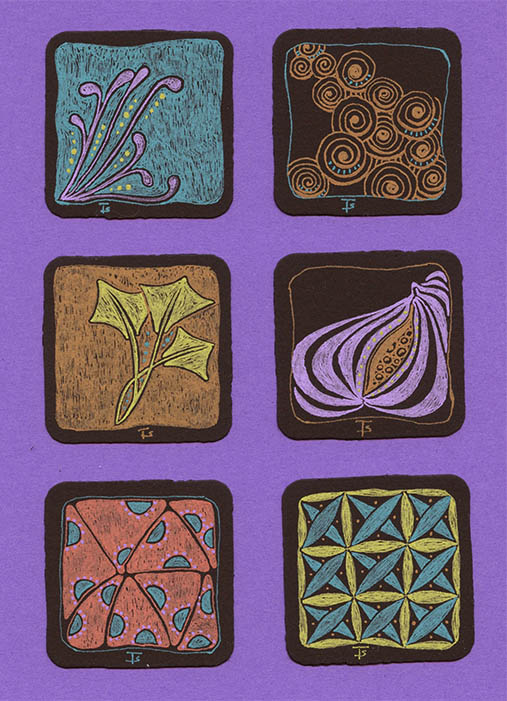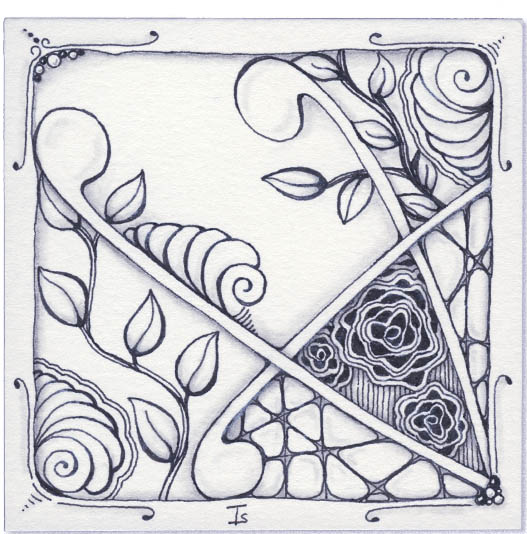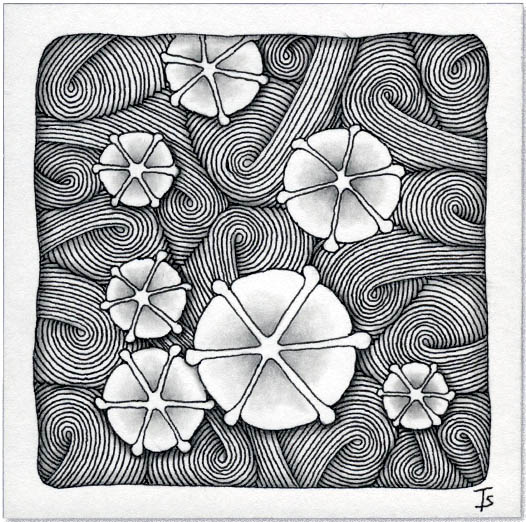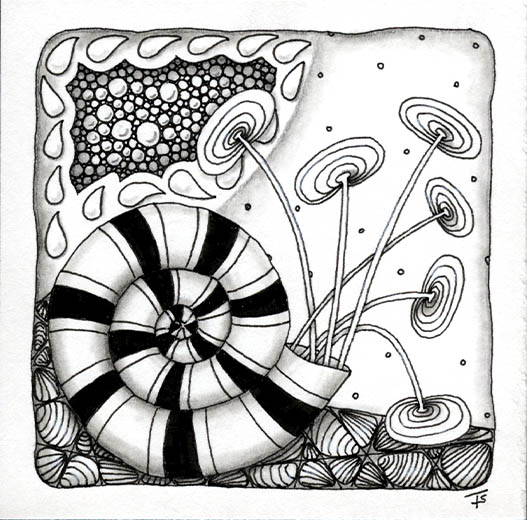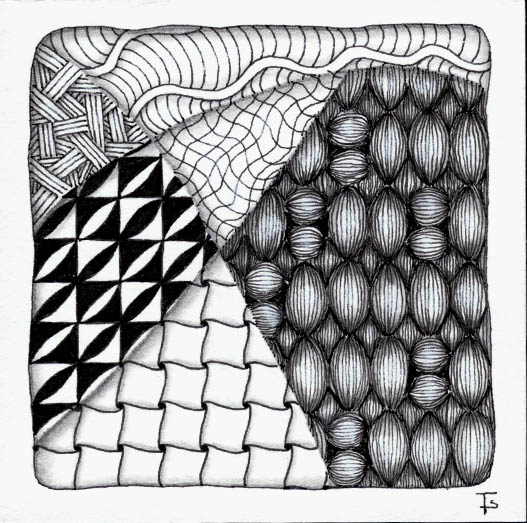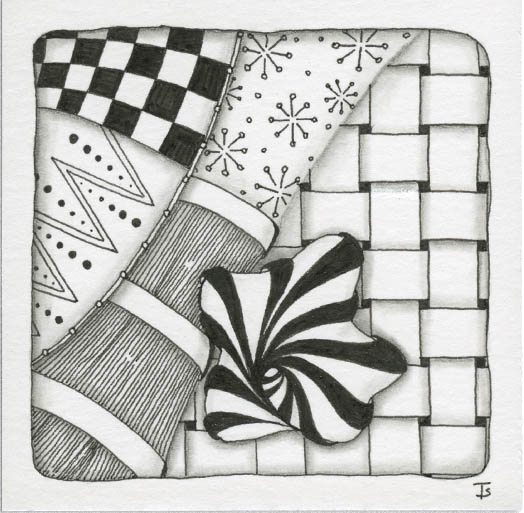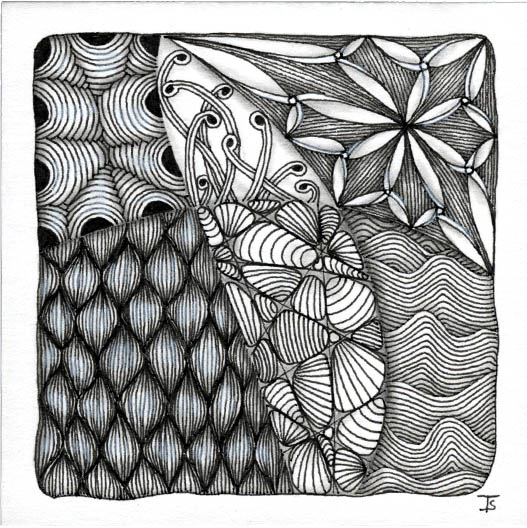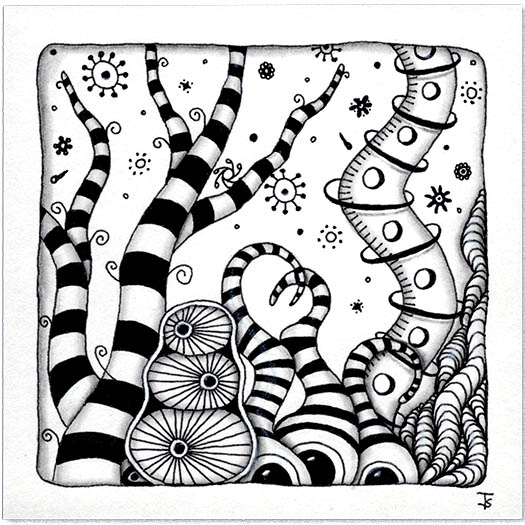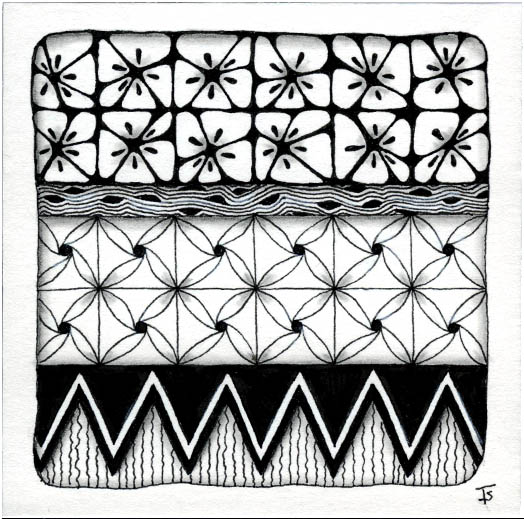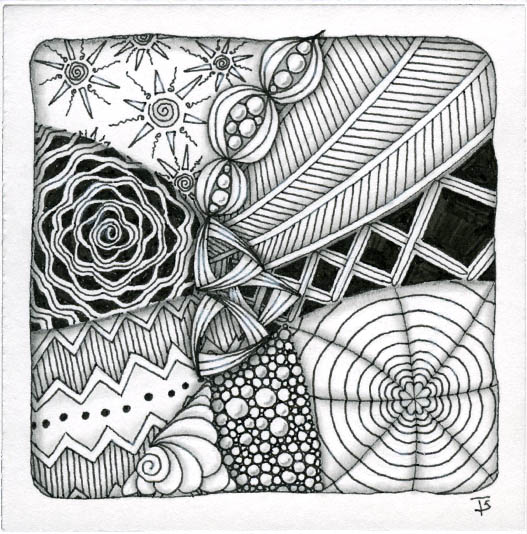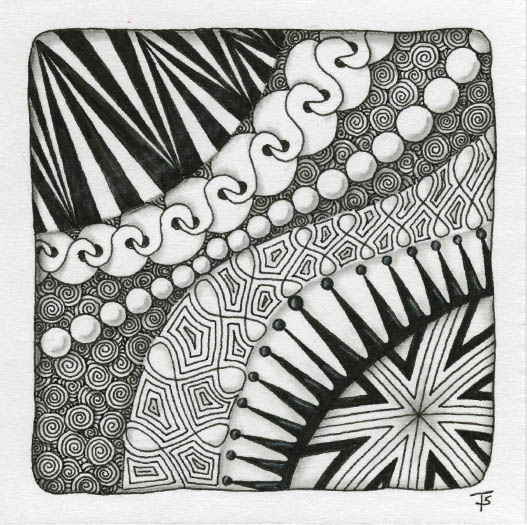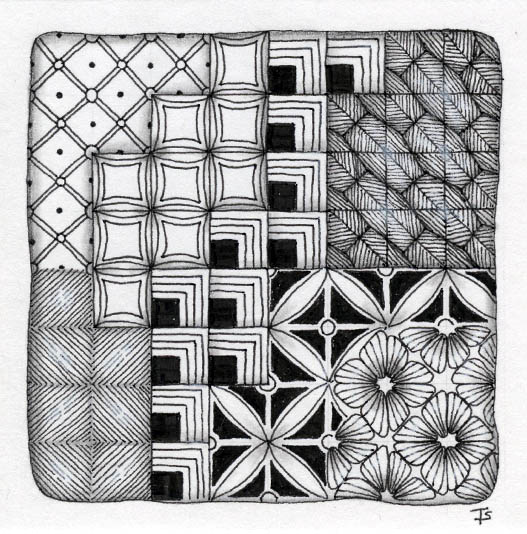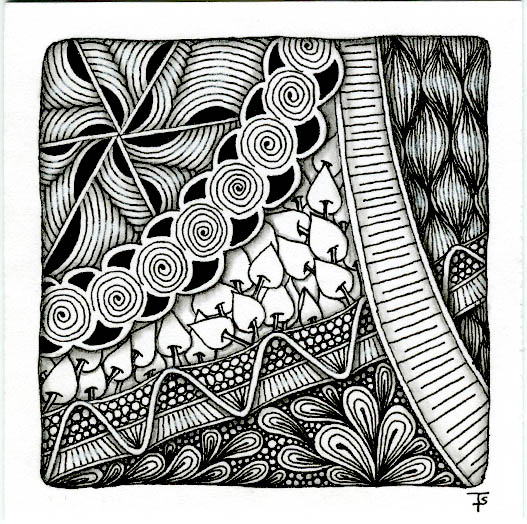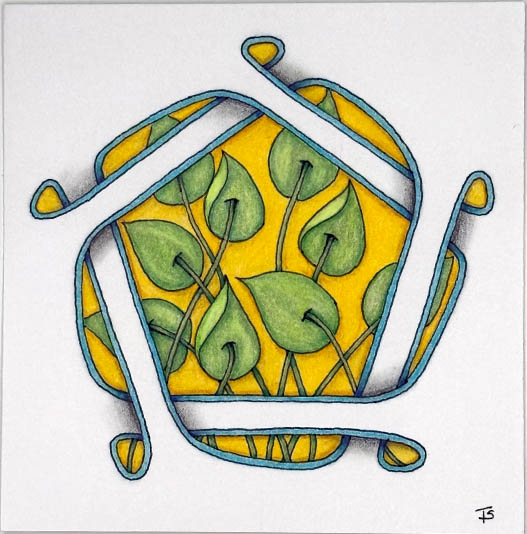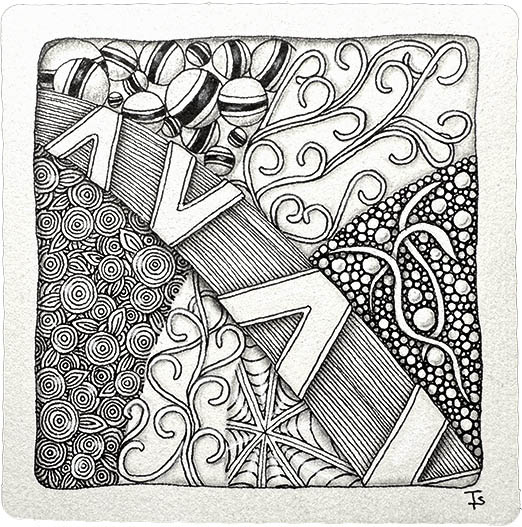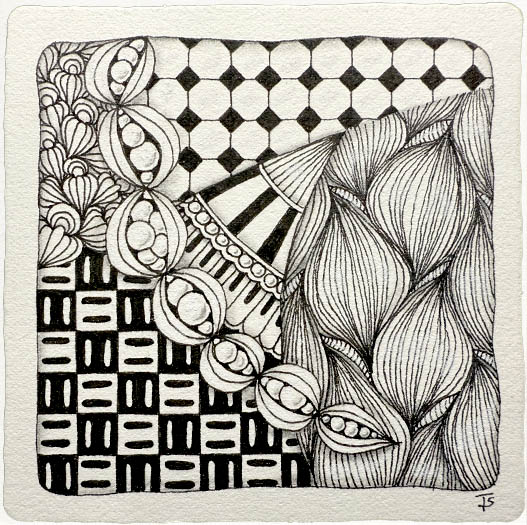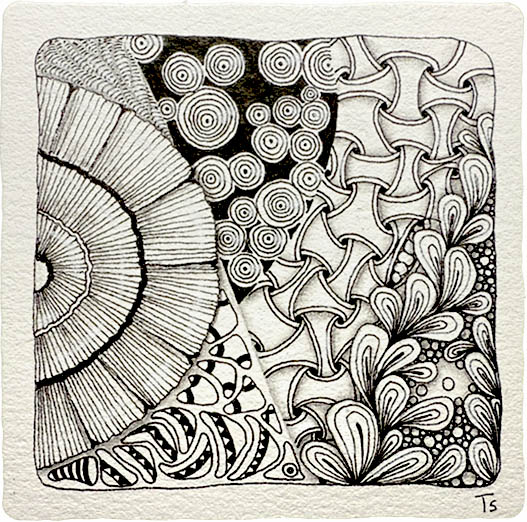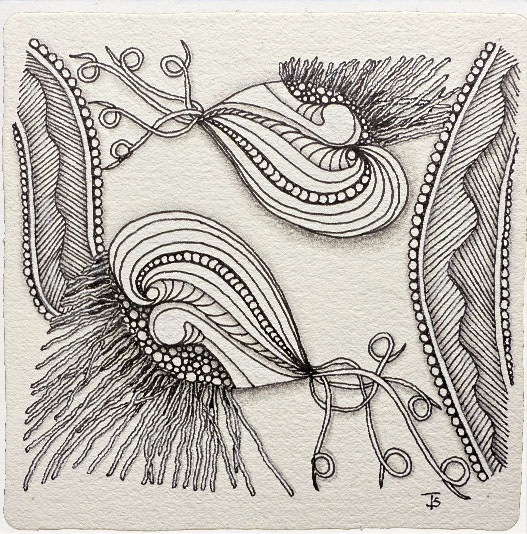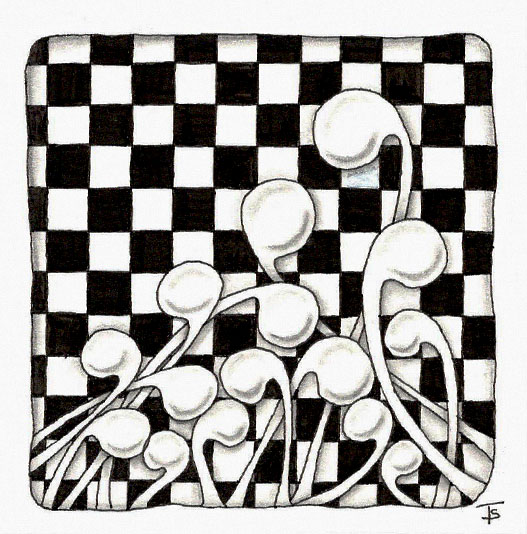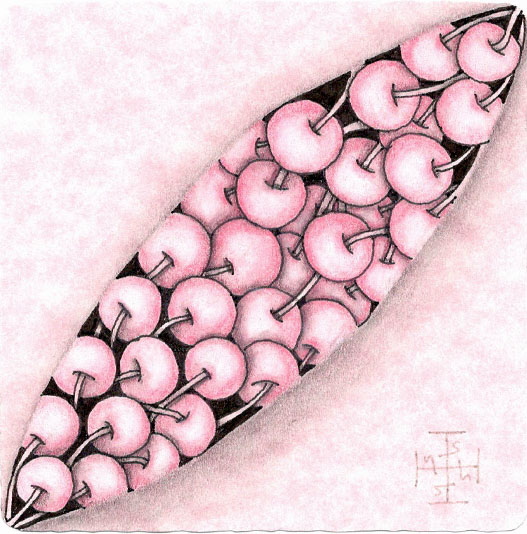These are “practice” tiles for an upcoming project for mid-July. I like them so much that I am posting them now. The middle one on the left doesn’t exactly have a name… It may be derived from Toodles (possibly).
For those of you who’ve done this project in the past: Shhh!
Zentangle drawn on a Zentangle, black, Bijou tiles. Drawing was done using several colors of Sakura’s Moonlight gel pens.
Dingbatz.
Dingbatz are the Zentangle version of printer’s ornaments called dingbats! They are small, ornamental areas of tangling that can be done on a tile, applied to an envelope, card or stationary. They could be used as stickers, or even used in your day planner to highlight an event or important appointment.
I am currently working through the “ Zentangle Dingbatz ” book by Brian Crimmins, CZT.
I decided to try a few ideas on a regular-sized, square tile for my first attempt.
Continuing a with a bit of ocean theme.
I learned this version of Tripoli from watching a video in which Martha (from Zentangle) described taking her children to the local aquarium and watching the jelly fish. While these don’t look exactly like them, it does invoke the feeling of moon jellies!
I chose the Sand Swirl tangle for the background to act as a contrast to the individual motifs.
I love Marasu! This version makes me wonder what kind of odd creature is living inside of it.
Zentangle drawn on Strathmore Vellum Bristol using a black, Micron pen. Shading done with graphite pencil. Highlights done with white colored pencil.
#drawing #tile #zentangle
Tangles: Cockles 'N' Mussels Ennies Marasu Sedgling
Random tangles, random string.
I haven’t drawn Socc in many years. I have a “tangle step-out card” that I made years ago for this tangle. However, I didn’t look at it very closely, thinking “I know how to do this.” Well, I didn’t. Instead of using the grid line as my starting point, I drew “inside the boxes”. I didn’t realize my mistake until it was part way done. I guess I’ve created a new, related but different tangle.
Random tangle selection. I haven’t drawn Aquafleur in forever! It came out much better than I remembered it to be!
Zentangle drawn on Strathmore Vellum Bristol using a black, Micron pen. Shading done with graphite pencil.
#drawing #tile #zentangle
Tangles: Aah Aquafleur Bridgen Chartz Knight's Bridge W-2 Zander
When I was first learning to tangle, Sandy Steen Bartholomew was one of the few people who had published books on the subject. She has a very unique style, which I found fun and engaging. In particular, her Btl Joos I really loved.
I am also attracted to things that are cute, with a little bit creepy twist.
Last night, when I was randomly picking tangles to use for today’s tile, Squirmy came up. That got me thinking about digging into my files and using as many tangles as I could round up that would go with it…
Yesterday’s tile was complex… Today’s is simple.
Only four tangles, arranged in horizontal bands with bold areas of black to tie everything together and balance the composition made for a very Zen drawing experience!
Zentangle drawn on Strathmore Vellum Bristol using a black, Micron pen. Shading done with graphite pencil. Highlights done with white colored pencil.
Tangles: Diva-Dance Florez Knase Well
Complex. There are days when our lives are full of complication. This tile reminds me that there is a way of organizing and taking things one step at a time that restores calm and confidence.
There are a lot of tangles here, with many not seeming to go together at all. But the Zentangle Method does an amazing job of making it all work, ending up with a tile that makes artistic sense.
A few, very bold tangles can make a huge statement, taking over the whole design. In this case, I tried to balance them out by placing them in opposite corners.
The Beedz tangle was originally shown with the orbs colored in with the pen, leaving only a bright highlight. I thought they would look better just left white in this composition.
Zentangle drawn on Strathmore Vellum Bristol using a black, Micron pen. Shading done with graphite pencil. Highlights created with white chalk pencil.
What would you do if you were selecting tangles randomly and they were all grid type?
Here, the “string” was a grid that covered the entire design area. Each tangle was applied within this grid, with any additional lines added to the grid as needed.
I like the way this came out, and I like the variations within the various tangles.
Fun!
Zentangle drawn on Strathmore Vellum Bristol using a black, Micron pen. Shading done with graphite pencil.
Several “ribbon” type tangles appeared in the random selection today. I used them to create the “string” and filled in the spaces between with more randomly selected tangles.
I think it worked out well!
Zentangle drawn on Strathmore Vellum Bristol using a black, Micron pen. Shading done with graphite pencil.
Tangles: Doo Dah Ixorus Olb Pais Pokeleaf Snail Twing
Ever since I saw the tangle Tissoooh, by Tomàs Padrós, I wanted to try using it as a frame for other tangles. Today, I got a chance to try it.
I kept it very simple, but I was very careful and deliberate with my lines, taking my time and thinking carefully before making each one.
After adding the Pokeleaf to the center, and having it peek through the “windows”, I used colored pencil to give all of it depth and dimension.
It looks like I need to practice the tangle “Hollis” more… This one kind of took off and created a life of it’s own!
Zentangle drawn on a standard, white Zentangle tile using a black, Micron pen. Shading done with graphite pencil. Highlights done with white chalk pencil.
Tangles: Claws Fracas Hollis Jetties Mysteria Pixoze
I used to be really nervous about trying anything based on an ogee grid, such as the African Artist tangle. I think I am finally over it. I have been practicingng drawing Narfello over and over and over, to the point where I am comfortable with it. So when African Artist came up, I was surprised at how easy it now feels!
Zentangle drawn on a standard, white Zentangle tile using a black, Micron pen. Shading done with graphite pencil. Highlights done with white chalk pencil.
Random tangles can play nice with each other!
For this tile I created a string and then filled it with randomly selected tangles.
This one worked well, and when I was done, I felt much closer to my normal tangling style. I had less hesitation, fewer crazy lines and the whole thing was very Zen, from start to finish.
Zentangle drawn on a standard, white Zentangle tile using a black, Micron pen. Shading done with graphite pencil. Highlights done with white chalk pencil
This started with a Zentangle tile that I found in my stash that had a string already drawn on it.
Then I started drawing tangles based on random numbers.
This system usually works really well for me… Usually.
The string had two large “loops” in it, and I thought they would work well to place the tangle Auragin. But it only filled part of the loops.
Adding 3d Mookas looked ok, but still left some room.
It’s a new month!
Yesterday, I didn’t tangle. Having finished the Bijou Be Well challenge, I took the day off.
Today, I wanted to do something simple and bold, since I was returning to my basic routine.
I love Mooka, and I often use this version as a bit of a representation of people… in this case, a large crowd. They look like they are having a party with lots of conversations going on to me.
This is the final day for Zentangle’ “Bijou Be Well” project, 2025 version, in honor of Mental Health Awareness Month. I began on May 10, and you can read that post here I’ve stuck with this project, tangling every day for 21 days! I did it when it was easy and fun. I did it when I wasn’t having a great day. I did it when I loved the tangle and the creation… and when I didn’t.
